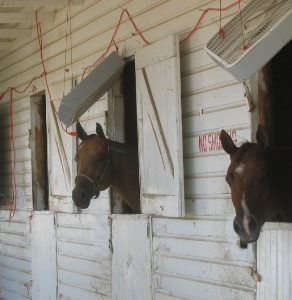Horse owners who have a sound understanding of horse behavior can use their knowledge to help prevent behavioral problems. Listed below are a few management tips related to horse behavior.
- Design horse housing so that horses can see other horses.
- Feeding horses individually will reduce aggression and allow slow eaters to get their full ration.
- Whenever possible, the main portion of the horse’s diet should be made up of forages to reduce digestive and behavioral problems.
- Feed stalled horses small frequent meals rather than several large meals to reduce boredom and digestive problems.
- If horses are fed in groups, provide more feeders than the number of horses in the group and distribute the feed rapidly so that all horses can begin eating at approximately the same time.
- Practice good pasture management to encourage horses to graze the majority of the available forage.
- Make fences and other barriers easily visible to the horse.
- When putting horses in a new area, give them plenty of daylight hours to locate new fencing and pasture hazards.
- Closely monitor new horses when introducing them into an established herd and be ready to separate horses if they become too aggressive.
- Be observant for signs of unwanted contagious behaviors (alarm reactions, running, etc.) in horses and do not allow these behaviors, inadvertently, to become the normal reaction of the horses to management procedures.
- Be aware of the horse’s dominance hierarchy and watch for signs of aggression when working in a group of horses.
- Keep feed rooms and gates securely fastened and fence horses away from dangerous areas.
- Separate foaling mares from geldings and stallions.
- When moving mares with foals, make sure the foal is awake and alert before moving the mare.
- Be careful separating horses that are accustomed to being housed together.
- Give stalled horses opportunities for free exercise and socialization.
- Use safe, sturdy fencing between groups of horses.
- Remove halters when horses are stalled or turned out. If halters cannot be removed, use a break-away safety halter.
For more information on horses, check out the HorseQuest Learning Lesson: Basic Horse Care and Management.



